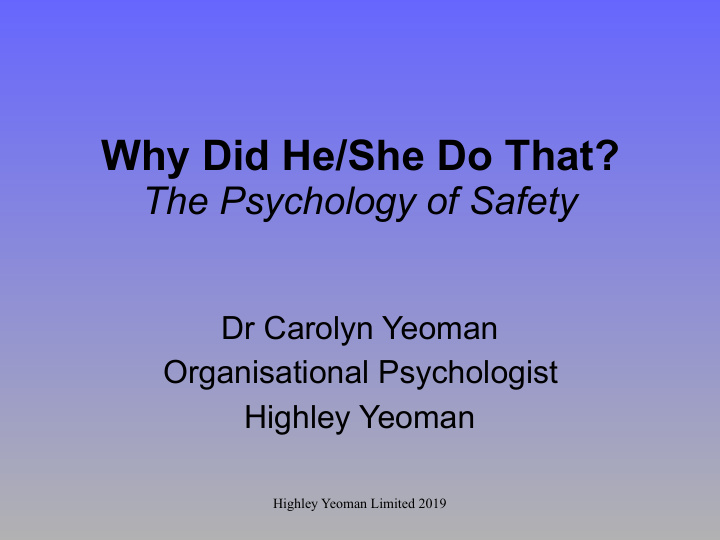



Why Did He/She Do That? The Psychology of Safety Dr Carolyn Yeoman Organisational Psychologist Highley Yeoman Highley Yeoman Limited 2019
People don’t go to work to injure themselves or others! ….. so why do we treat them like they do? We often ask Who? rather than ‘Why? BLAME!! Highley Yeoman Limited 2019
Violation or Error? Violations Intentional and might be the result of: – perception that the company values production over safety – being rewarded for the risk taking – reckless behaviour, sabotage or revenge (occasionally) – poor leadership
Did you follow the procedure? • “We didn’t have the right equipment” • “We haven’t done it that way for years” • “We didn’t have time” • “We lacked sufficient manpower” • “We thought we could skip a few steps to get the work out and still be safe” • “The procedure didn’t cover it” • POOR LEADERSHIP & LACK OF ENGAGEMEN WITH THE WORKFORCE
Health & Safety Leadership The way teams are lead on health and safety determines how safe the organisation is: •The H&S attitudes and beliefs of leaders drives their behaviour •Their behaviour sends a powerful message to workers about how seriously they should take H&S •The root causes of many incidents can be traced back to managers’ decisions (From: Construction Industry’s Leadership and Worker Engagement Forum)
Violation or Error? Violations Intentional and might be the result of: – perception that the company values production over safety – being rewarded for the risk taking – reckless behaviour, sabotage or revenge (occasionally) – poor leadership Errors Unintentional and might be the result of: – workplace design – poor quality training and competence development – inadequate procedures – BEING HUMAN! – lack of wellbeing
Human Error “Investigations that conclude that human error was the sole cause are rarely acceptable. Underpinning the ‘human error’ there will be a number of underlying causes that created the environment in which human errors were inevitable”. Investigating accidents and incidents, HSE, HSG245
The Myths • Human error is a choice • No events means no human error problems • Training will solve human error problems • Accountability/punishment will address human error • Experience eliminates human errors • Human errors are the root cause of accidents • Errors are violations, errors are bad
Human Error - Symptom not Cause • Errors are shaped and provoked by upstream workplace and organisational factors “You cannot change the human condition, but you can change the conditions under which humans work” James Reason
Human Error Root Cause Analysis • Loss of focus Workplace • organization Increased distraction from tasks Work overload • Increased likelihood of errors Repetition Managerial +Time binding behaviour • activities New tasks/procedures not well acquired +Job stress Lower autonomy asked to be faster Unsupportive and control of their • Unhealthy employees and more efficient supervision tasks Peer pressure • Physical and cognitive limitations Ageing/ Not fit / Health (physical & psycho) & Social problems/ Bad nutrition/ Low emotional resilience • Less motivation to follow rules Long working Psychological • Shortcuts trend hours Job uncertainty +Paperwork distress • Fatigue Poor work +Overtime Roles and scopes relationships +Extra controls not clear • Increased intoxication (medicines, (Quality, Lean, SAP,…) Fast pace of work drugs). External benefits
History of Safety Highley Yeoman Limited 2019
Putting the HEALTH into H&S ‘You can’t be a safe worker if you’re not a healthy worker .’ - Professor Dame Carol Black Expert Adviser on Work and Health, Department of Health, England
Wellbeing, Engagement and Leadership •Wellbeing underpins Leadership engagement •An engaged workforce Engagement is both safe and (performance) productive Wellbeing •Engaging leadership is (caring) key Hard- Girling Integrated Improvement model
What We Hear! In any business It’s people that give a A company is only as what makes the People first! meaning to the good as the people it difference is the company! keeps people! . Great companies People innovate not We are people People are our are built by companies! centric! most important people that... asset!
If our most important asset is our people, then how can we not yet ensure their HEALTH and Safety while at work?
Everyone seems to know that …. in the long run, companies that promote and protect their people are among the most successful and competitive in the world! Taking care of our people is the Right, Smart and Legal thing to do!
Thank you for listening Dr Carolyn Yeoman Highley Yeoman Limited carolyn@highley-yeoman.co.uk Highley Yeoman Limited 2019
Recommend
More recommend